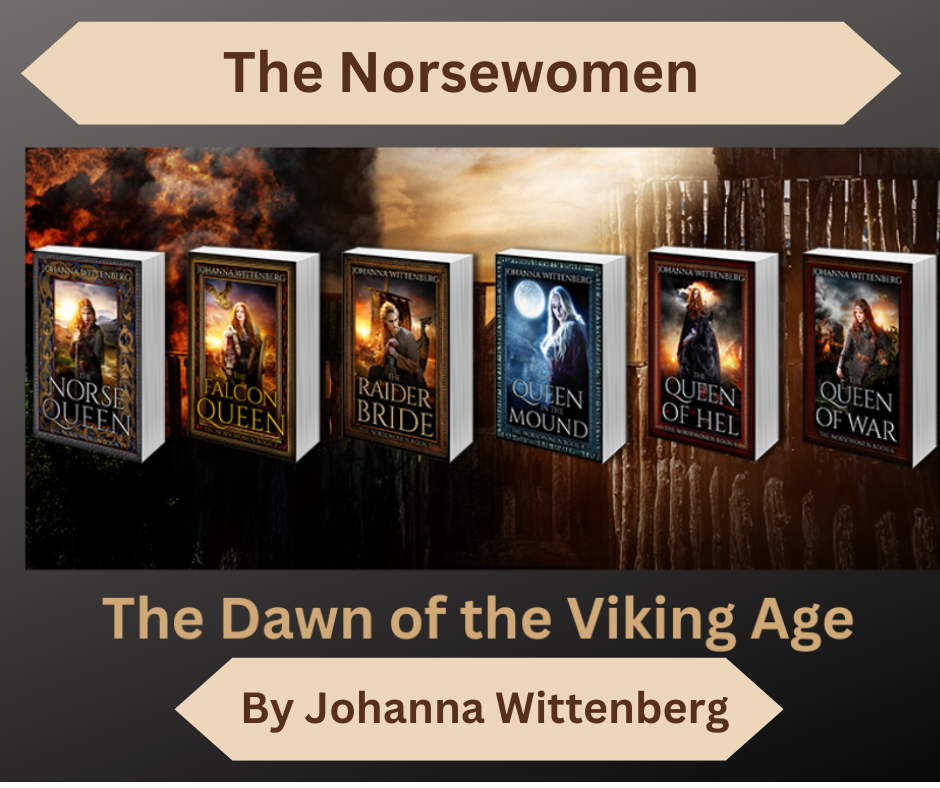
02 Jun Author Interview Johanna Wittenberg #Vikings #Norsewomen #Shieldmaidens
AUTHOR INTERVIEW JOHANNA WITTENBERG
I am excited to feature Johanna Wittenberg—the author of the best-selling The Norsewomen series. I became acquainted with Johanna’s work when I reviewed The Queen of Hel (Book 5) and The Queen of War (Book 6) for the Historical Novel Society (HNS). Johanna is a masterful storyteller reminiscent of the oral traditions of skalds retelling Nordic mythological tales and legends. The saga sweeps you into the adventures of the seafaring Vikings and depicts their religious beliefs and culture. Battle scenes and mythical realms of the afterlife are riveting and cinematic in scope.
Johanna graciously accepted my invitation for an interview which provides a fascinating insight into her as an author and her books. In addition, below are highlights of her last two books (The Queen of Hel and The Queen of War), her author bio, and social links.
HIGHLIGHTS: THE QUEEN OF HEL
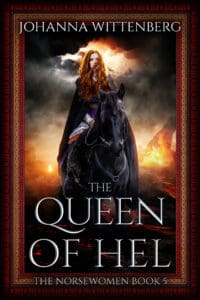
The Queen of Hel
(Book 5 The Norsewomen)
by Johanna Wittenberg
Blurb:
Norway, AD 824. The evil Queen in the Mound is dead, the Irish necklace held fast in her ghoulish grip. Undisturbed, the queen’s curse lies dormant. But Ragnhild attempts to retrieve the necklace, unleashing a pestilence on Tromøy. As her people sicken and die, Asa must seek the cure in the Otherworld. Leaving her beloved son behind, she travels alone to the dark world deep underground, a place from which mortals never return. The realm of Hel herself.
Available on Kindle Unlimited
Universal buy link: https://mybook.to/Queenofhel
The Nordic saga The Queen of Hel (Book 5 of The Norsewomen) continues the mythological adventures of historical figures and legends from Norway and Ireland in 824 CE. The epic tale begins when Ragnhild, a female warrior, travels to Tromøy to retrieve the queen’s necklace that she secretly stole from her husband’s cousin, a king in Ireland. To avoid a rift in her husband’s family, she must return the pendant before it is discovered missing. Ragnhild learns Åsa has beheaded and buried the former evil queen with the gold chain clutched in her hand. As a result of Ragnhild digging up the corpse to recover the powerful necklace, a deadly disease unleashes over the land. Desperate to find a cure, Åsa must travel to Hel and find the queen from the mound to lift the curse. But no mortal has ever returned from the dark, underground world.
Author Johanna Wittenberg’s narrative prose is reminiscent of the rich tradition of oral storytelling during the Nordic heroic age. Mythical elements are woven into Åsa’s odyssey as she rides on horseback through Niflheim—the land of freezing mist—to reach Hel. Vivid sensory descriptions of the Otherworld and the travails Åsa must overcome are cinematic and epic in scope. The saga not only sweeps you into the mystical realms of the afterlife, it historically depicts Nordic culture, oral traditions, and seafaring adventures to Ireland, where Celtic religion and Christianity clash. Glossaries of characters, terms, and gods and heroes help readers navigate through the tale.
The Queen of Hel seamlessly weaves elements of Norse and Celtic mythology into an epic Viking adventure that will enthrall readers with its evocative and imaginative storytelling.
Historical Novel Society HNR Issue 104 (May 2023)
HIGHLIGHTS: THE QUEEN OF WAR
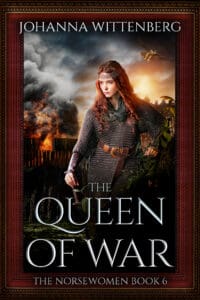 The Queen of War
The Queen of War
(Book 6 The Norsewomen)
by Johanna Wittenberg
Blurb:
An old enemy has been secretly watching Tromøy, probing for any weakness. An opportunity presents itself and he strikes, capturing Åsa. Imprisoned by a mighty king and his powerful sorceress, Åsa must survive by her wits while her allies launch a desperate rescue attempt against overwhelming odds. Cornered and outnumbered by her enemy, Åsa summons the dark power of war magic to save her people.
Available on Kindle Unlimited
Universal buy link: https://mybook.to/Queenofwar
The epic Nordic saga, The Queen of War (Book 6 of The Norsewomen), continues the legendary tale of Queen Åsa from Tromøy, an island off the east coast of Norway. Sufficient backstory is provided so the book can be read as a standalone. The tale begins in 825 CE, a year after Åsa survived an odyssey to Hel to break a curse that unleashed a deadly plague in her kingdom. With her kingdom at peace, she arranges for her six-year-old son to be mentored by his biological father and her previous secret lover. However, her world turns upside down when she is captured by the Danish king, Horik, who is determined to make her his queen in his scheme to conquer and rule the Norwegian coast. Against all odds, Åsa has to find a way to escape imprisonment and warn her Norse allies of Horik’s threat. She must rely on her cunning and magic to thwart the Danish invasion and save her people.
Author Johanna Wittenberg is a masterful storyteller reminiscent of the oral traditions of skalds retelling mythological tales and legends. The author vividly describes battle scenes that are riveting and cinematic in scope. The fast-paced adventure races to a heart-throbbing climax where Norsemen and Danes ultimately clash. Mystical elements seamlessly weave into the historical backdrop of medieval Scandinavia. A sorceress, Åsa can cast spells and spiritually meld with a falcon to see through its eyes. A list of characters, maps, and glossaries of Norse terms, gods, and heroes helps the reader to navigate through the story.
The Queen of War is an epic adventure that captures the battle tactics, religious beliefs, and culture of the seafaring Vikings. Highly recommended.
Editor’s Choice Historical Novel Society HNR Issue 108 (May 2024).
THE NORSEWOMEN SERIES
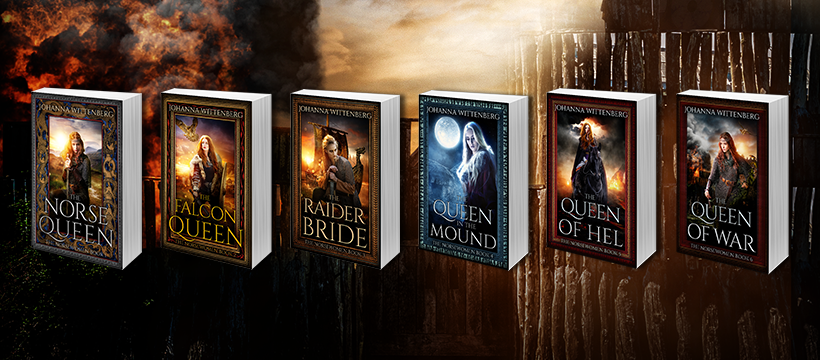
Universal buy link: https://mybook.to/TheNorsewomen
Genre: Historical Fiction, Historical Fantasy, Historical Norse & Icelandic Fiction, Norse & Viking Myth & Legend
AUTHOR BIO: JOHANNA WITTENBERG

Johanna Wittenberg is the author of the bestselling The Norsewomen Series, the story of Åsa, a real Norse queen who ruled alone during the early Viking Age. Like her Viking forebears, Johanna has sailed to the far reaches of the world. She lives on a fjord in the Pacific Northwest with her husband, whom she met on a ship bound for Antarctica.
Social Links:
Author Website: https://johannawittenberg.com
Facebook: https://www.facebook.com/TheNorseQueen
Instagram: https://www.instagram.com/norsewomen5/
Bookbub: https://www.bookbub.com/authors/johanna-wittenberg
AUTHOR INTERVIEW: JOHANNA WITTENBERG
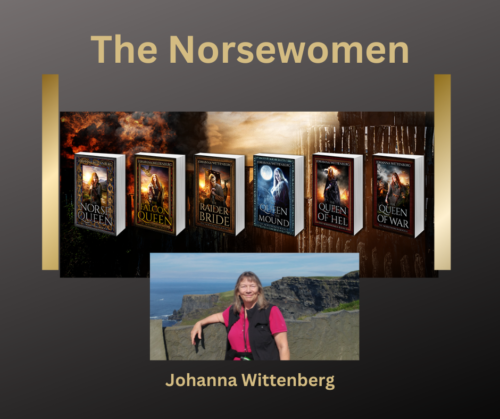
Would you give us an overview of the books you’ve published in The Norsewomen series?
So far the series consists of 6 books, starting with The Norse Queen. The first book is based on the brief tale of Queen Åsa from Snorri Sturleson’s Heimskringla. In the subsequent books, I imagined Åsa’s life after she vanished from history, using what I had learned from my extensive research into archeology, myth, and the sagas.
Please tell us more about your most recently released books: The Queen of Hel (Book 5) and The Queen of War (Book 6) in The Norsewomen series.
The Queen of Hel focuses on Åsa’s journey to the realm of Hel. It’s based on several accounts drawn from the sagas. In the second half of the book, the shield-maiden Ragnhild journeys back to Ireland to return a cursed necklace she had stolen. She defends the holy island of Iona from a Viking raid and has a run-in with the Picts of Dal Riata.
In The Queen of War Åsa is kidnapped by the Danish King Horik (a real person) and she must use her wits and magic to escape, while her allies launch a desperate rescue attempt. I was fascinated by Horik’s history as well as the archeology of a fortress that may have been his stronghold.
What inspired you to write about legendary women in The Norsewomen series?
My mother, an artist of Norwegian descent, created a series of images that revived the ornamental style preserved in wood carvings and metalwork of the Viking age. Her art now graces my covers. Together we discovered Queen Åsa. I was enthralled by the idea that a woman ruled alone for 18 years in the early Viking Age, a time of constant war and violence in Scandinavia. What kind of woman could do that?
Mom introduced me to the museums of Oslo. I spent hours in them, especially the Viking Ship museum which housed the magnificent Oseberg burial ship.
It is a 70-foot Viking longship loaded with artifacts, one of the greatest ship burials found in Norway and one of the most important discoveries that show us how people lived in the Viking age. The burial contained the remains of two women, and no evidence of any men. It is thought by many to be Åsa’s grave.
There are numerous other burials throughout Scandinavia that suggest some women held great power and status during the Viking Age.
How much research was involved in writing your books? How did you go ABOUT researching the history, myths, language, and culture of the Vikings?
I put in literally years of research. The first book took me 6 years to write and publish. The subsequent books in the series take about a year each from beginning to end. I love research! I have a substantial research library, each book bristling with post-it flags. I use the internet extensively as well, with scholarly sites such as Academia.edu and JSTOR.org. I have traveled to Scandinavia and Ireland several times and walked the lands in my stories. I really want to be there, to see the events in real life, and writing fiction is the next best thing.
Why did you choose to weave mythological elements into The Norsewomen series?
Accuracy. I started out writing a straight historical novel with no supernatural elements, but soon discovered that it is virtually impossible to portray the era accurately without including the spiritual beliefs of the time. During the early medieval period, everyone believed in magic and the gods, even Christian priests. They believed in it to the extent that they wrote laws forbidding specific magical practices. I want to show the world as the Vikings saw it, not as a modern person sees it. For the reader to immerse themselves in the world, magic has to be real. The supernatural and mythological elements I portray in my books is based on careful research and is as true to what the Norse believed as I can make it. I have a lot of fun with it, too, especially in The Queen of Hel.
Is there any sub-character in The Queen of Hel (Book 5) OR The Queen of War (Book 6) who is your favorite? Explain why.
I love Brother Brian. He just popped into my mind as I was writing, with his entire history. I love the idea of a gentle druid who has transcended time and space. Another favorite is Cian. He also popped into my mind as I was writing. King Horik was playing chess, and I became aware that he was playing with someone…a slave… Cian appeared, with his thoughts and then his back story of a gifted harper. These types of characters are so real to me!
What is your favorite quote from one of your books in The Norsewomen series?
She remembered a song her mother taught her when she was very young, a vardlokkur, in words humans could not understand. It was a song to call the dísir, the loving spirits of the dead.
PODCAST: SHIELDMAIDENS
Johanna Wittenberg has a monthly podcast, Shieldmaidens, Women of the Norse World, with fellow author K.S. Barton. They have a great time sharing their research as well as some good Norse legends. Here’s a link tree to most platforms like Spotify: Shieldmaidens: Women of the Norse World. It’s also available on Youtube; here’s a link to the latest episode: Shieldmaidens on Youtube.


No Comments